Leadership and Management Theories: A Comprehensive Analysis Report
VerifiedAdded on 2022/08/25
|6
|1393
|25
Report
AI Summary
This report delves into the realm of leadership and management, examining various theories and styles. It begins with a reaction and reflection on Canadian nurse leadership, highlighting their perspectives on organizational leadership and the challenges faced within the healthcare system. The report then explores a range of leadership theories including bureaucratic, quantum, trait, contingency, and contemporary styles such as democratic, transformational, and servant leadership. It differentiates between leaders and managers, outlining their distinct roles and responsibilities within an organization. Furthermore, the report includes a self-assessment of leadership style, identifying a preference for the participative or democratic approach, and discusses the advantages and disadvantages associated with it. Finally, the report addresses an in-basket exercise, providing a practical application of leadership principles in handling various scenarios, such as staffing issues, communication with stakeholders, and decision-making processes.
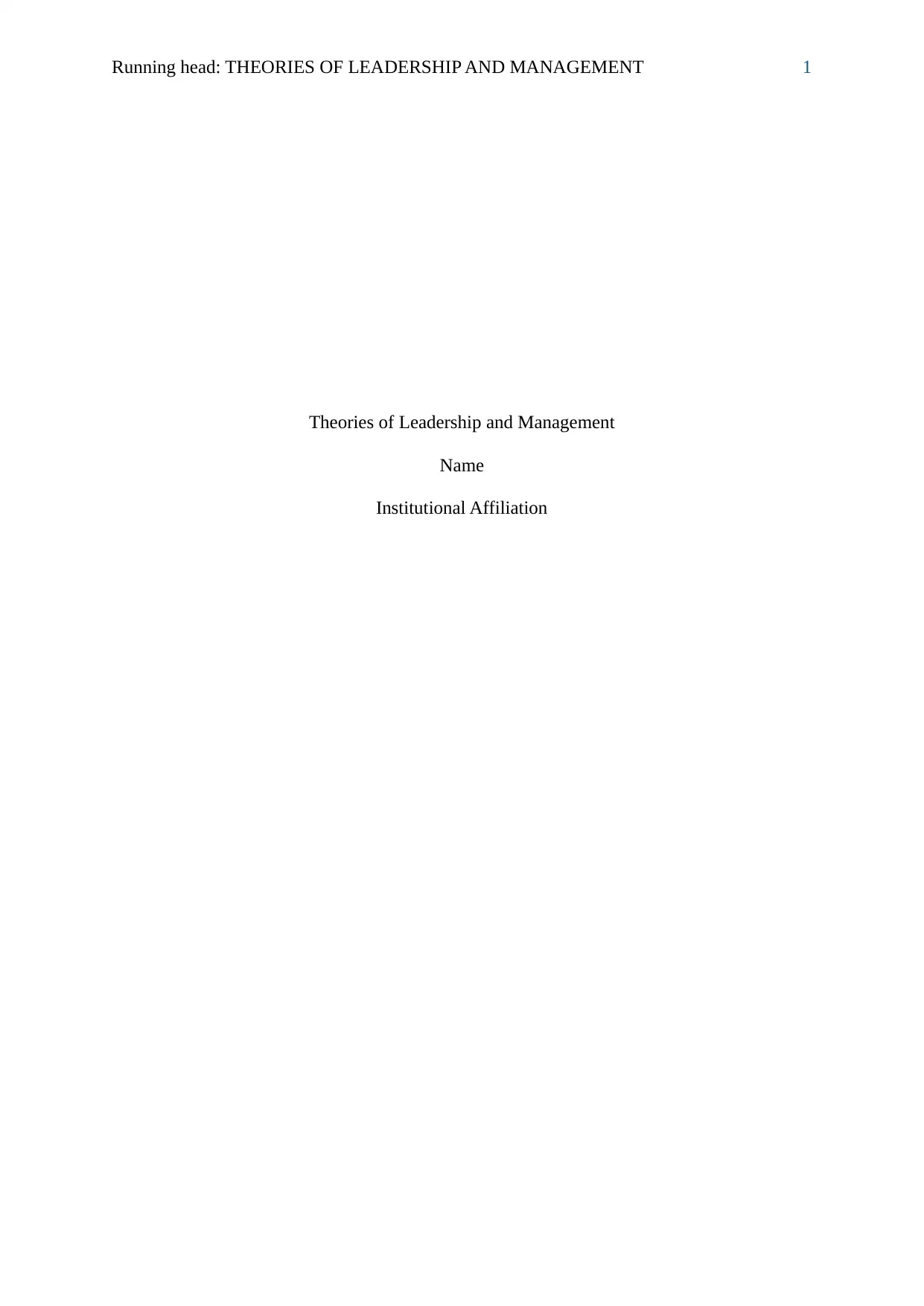
Running head: THEORIES OF LEADERSHIP AND MANAGEMENT 1
Theories of Leadership and Management
Name
Institutional Affiliation
Theories of Leadership and Management
Name
Institutional Affiliation
Paraphrase This Document
Need a fresh take? Get an instant paraphrase of this document with our AI Paraphraser
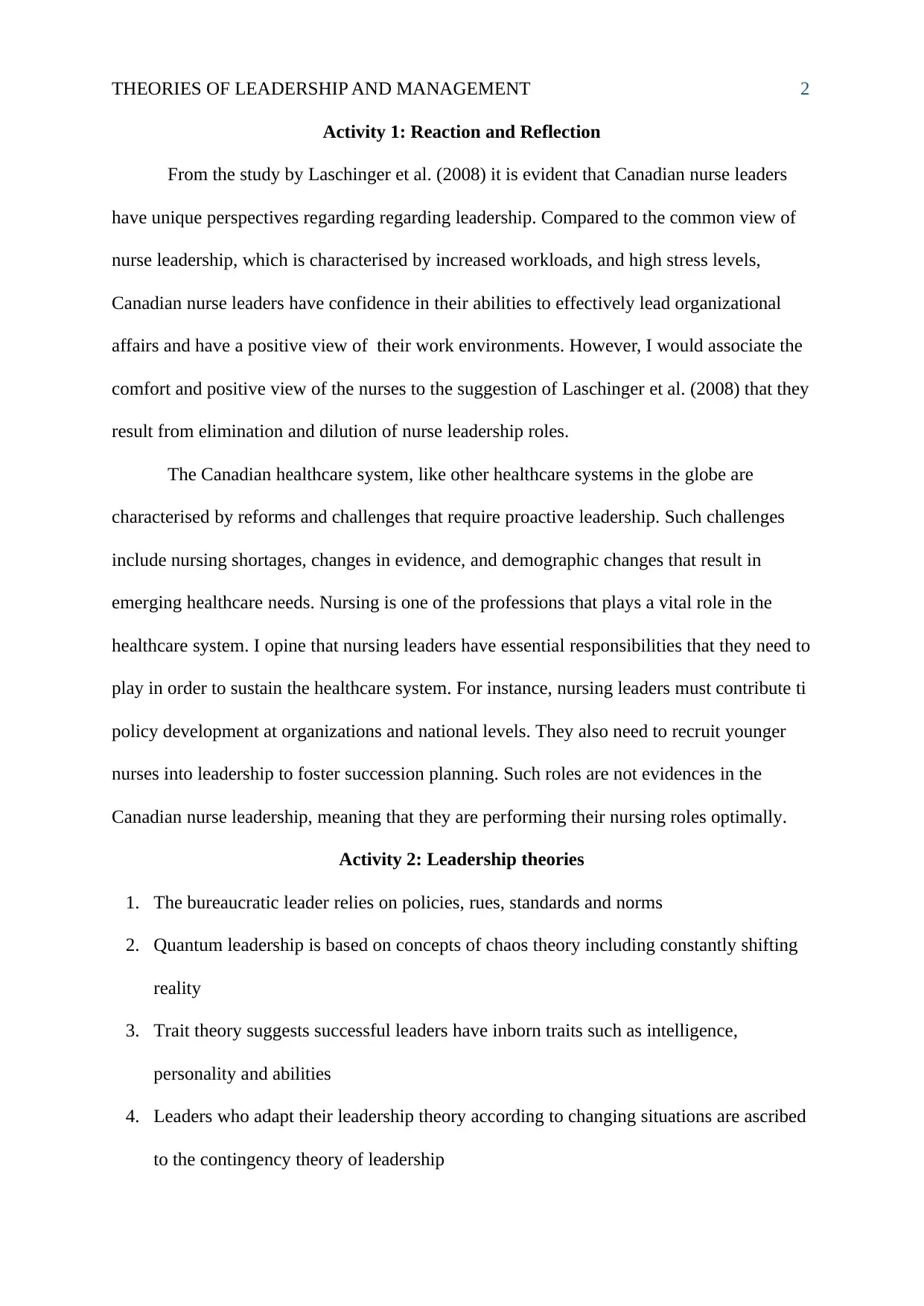
THEORIES OF LEADERSHIP AND MANAGEMENT 2
Activity 1: Reaction and Reflection
From the study by Laschinger et al. (2008) it is evident that Canadian nurse leaders
have unique perspectives regarding regarding leadership. Compared to the common view of
nurse leadership, which is characterised by increased workloads, and high stress levels,
Canadian nurse leaders have confidence in their abilities to effectively lead organizational
affairs and have a positive view of their work environments. However, I would associate the
comfort and positive view of the nurses to the suggestion of Laschinger et al. (2008) that they
result from elimination and dilution of nurse leadership roles.
The Canadian healthcare system, like other healthcare systems in the globe are
characterised by reforms and challenges that require proactive leadership. Such challenges
include nursing shortages, changes in evidence, and demographic changes that result in
emerging healthcare needs. Nursing is one of the professions that plays a vital role in the
healthcare system. I opine that nursing leaders have essential responsibilities that they need to
play in order to sustain the healthcare system. For instance, nursing leaders must contribute ti
policy development at organizations and national levels. They also need to recruit younger
nurses into leadership to foster succession planning. Such roles are not evidences in the
Canadian nurse leadership, meaning that they are performing their nursing roles optimally.
Activity 2: Leadership theories
1. The bureaucratic leader relies on policies, rues, standards and norms
2. Quantum leadership is based on concepts of chaos theory including constantly shifting
reality
3. Trait theory suggests successful leaders have inborn traits such as intelligence,
personality and abilities
4. Leaders who adapt their leadership theory according to changing situations are ascribed
to the contingency theory of leadership
Activity 1: Reaction and Reflection
From the study by Laschinger et al. (2008) it is evident that Canadian nurse leaders
have unique perspectives regarding regarding leadership. Compared to the common view of
nurse leadership, which is characterised by increased workloads, and high stress levels,
Canadian nurse leaders have confidence in their abilities to effectively lead organizational
affairs and have a positive view of their work environments. However, I would associate the
comfort and positive view of the nurses to the suggestion of Laschinger et al. (2008) that they
result from elimination and dilution of nurse leadership roles.
The Canadian healthcare system, like other healthcare systems in the globe are
characterised by reforms and challenges that require proactive leadership. Such challenges
include nursing shortages, changes in evidence, and demographic changes that result in
emerging healthcare needs. Nursing is one of the professions that plays a vital role in the
healthcare system. I opine that nursing leaders have essential responsibilities that they need to
play in order to sustain the healthcare system. For instance, nursing leaders must contribute ti
policy development at organizations and national levels. They also need to recruit younger
nurses into leadership to foster succession planning. Such roles are not evidences in the
Canadian nurse leadership, meaning that they are performing their nursing roles optimally.
Activity 2: Leadership theories
1. The bureaucratic leader relies on policies, rues, standards and norms
2. Quantum leadership is based on concepts of chaos theory including constantly shifting
reality
3. Trait theory suggests successful leaders have inborn traits such as intelligence,
personality and abilities
4. Leaders who adapt their leadership theory according to changing situations are ascribed
to the contingency theory of leadership
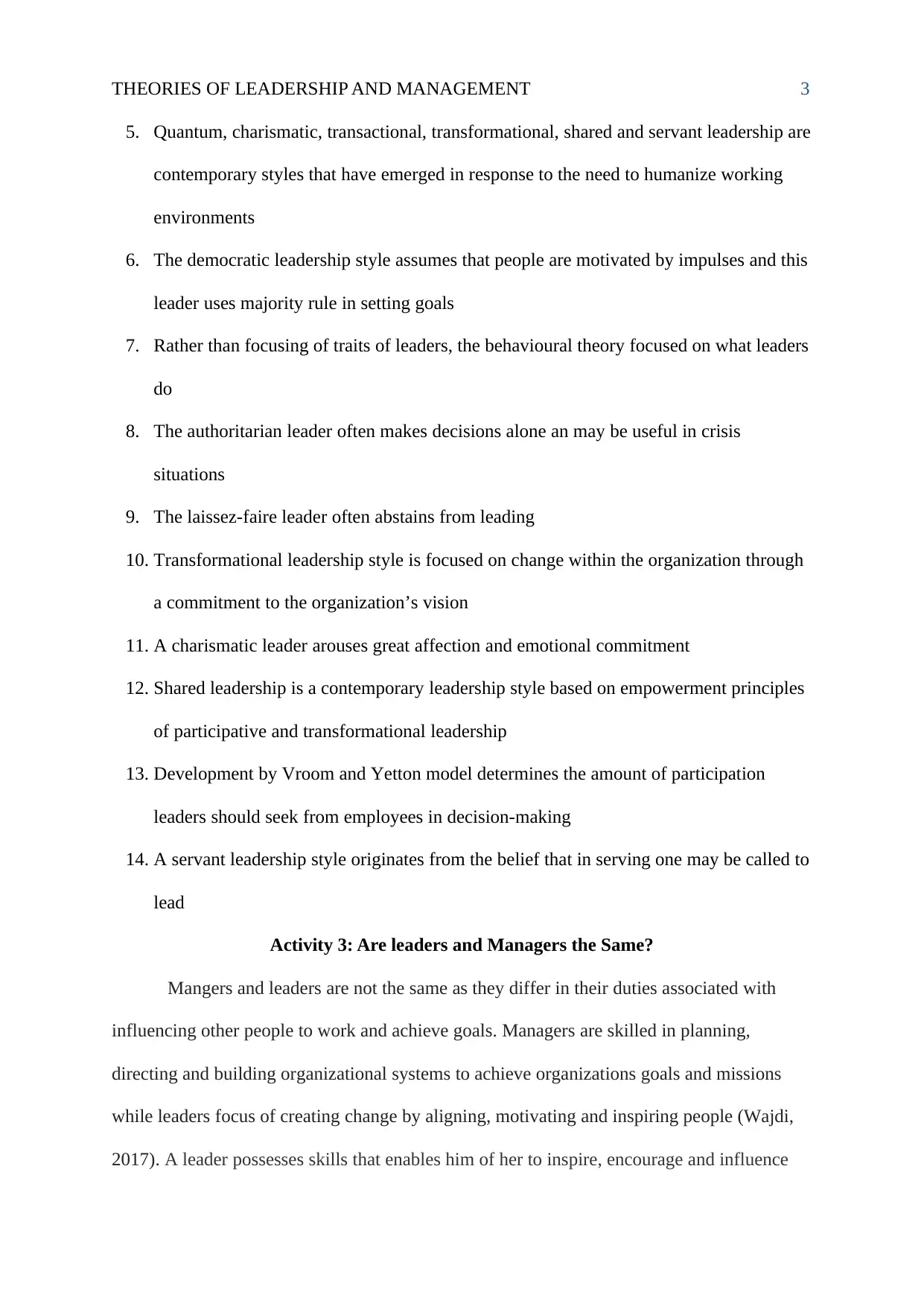
THEORIES OF LEADERSHIP AND MANAGEMENT 3
5. Quantum, charismatic, transactional, transformational, shared and servant leadership are
contemporary styles that have emerged in response to the need to humanize working
environments
6. The democratic leadership style assumes that people are motivated by impulses and this
leader uses majority rule in setting goals
7. Rather than focusing of traits of leaders, the behavioural theory focused on what leaders
do
8. The authoritarian leader often makes decisions alone an may be useful in crisis
situations
9. The laissez-faire leader often abstains from leading
10. Transformational leadership style is focused on change within the organization through
a commitment to the organization’s vision
11. A charismatic leader arouses great affection and emotional commitment
12. Shared leadership is a contemporary leadership style based on empowerment principles
of participative and transformational leadership
13. Development by Vroom and Yetton model determines the amount of participation
leaders should seek from employees in decision-making
14. A servant leadership style originates from the belief that in serving one may be called to
lead
Activity 3: Are leaders and Managers the Same?
Mangers and leaders are not the same as they differ in their duties associated with
influencing other people to work and achieve goals. Managers are skilled in planning,
directing and building organizational systems to achieve organizations goals and missions
while leaders focus of creating change by aligning, motivating and inspiring people (Wajdi,
2017). A leader possesses skills that enables him of her to inspire, encourage and influence
5. Quantum, charismatic, transactional, transformational, shared and servant leadership are
contemporary styles that have emerged in response to the need to humanize working
environments
6. The democratic leadership style assumes that people are motivated by impulses and this
leader uses majority rule in setting goals
7. Rather than focusing of traits of leaders, the behavioural theory focused on what leaders
do
8. The authoritarian leader often makes decisions alone an may be useful in crisis
situations
9. The laissez-faire leader often abstains from leading
10. Transformational leadership style is focused on change within the organization through
a commitment to the organization’s vision
11. A charismatic leader arouses great affection and emotional commitment
12. Shared leadership is a contemporary leadership style based on empowerment principles
of participative and transformational leadership
13. Development by Vroom and Yetton model determines the amount of participation
leaders should seek from employees in decision-making
14. A servant leadership style originates from the belief that in serving one may be called to
lead
Activity 3: Are leaders and Managers the Same?
Mangers and leaders are not the same as they differ in their duties associated with
influencing other people to work and achieve goals. Managers are skilled in planning,
directing and building organizational systems to achieve organizations goals and missions
while leaders focus of creating change by aligning, motivating and inspiring people (Wajdi,
2017). A leader possesses skills that enables him of her to inspire, encourage and influence
⊘ This is a preview!⊘
Do you want full access?
Subscribe today to unlock all pages.

Trusted by 1+ million students worldwide
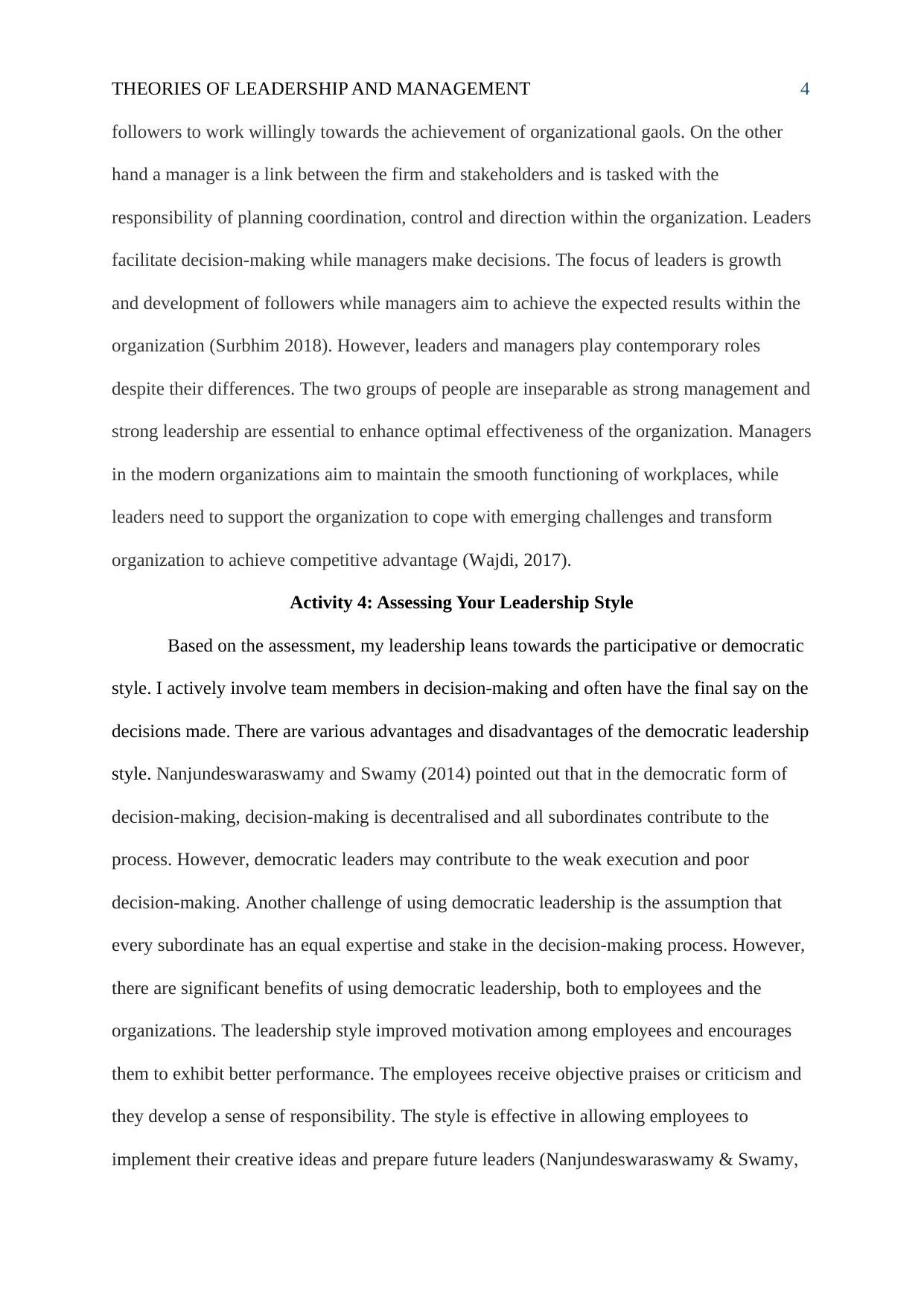
THEORIES OF LEADERSHIP AND MANAGEMENT 4
followers to work willingly towards the achievement of organizational gaols. On the other
hand a manager is a link between the firm and stakeholders and is tasked with the
responsibility of planning coordination, control and direction within the organization. Leaders
facilitate decision-making while managers make decisions. The focus of leaders is growth
and development of followers while managers aim to achieve the expected results within the
organization (Surbhim 2018). However, leaders and managers play contemporary roles
despite their differences. The two groups of people are inseparable as strong management and
strong leadership are essential to enhance optimal effectiveness of the organization. Managers
in the modern organizations aim to maintain the smooth functioning of workplaces, while
leaders need to support the organization to cope with emerging challenges and transform
organization to achieve competitive advantage (Wajdi, 2017).
Activity 4: Assessing Your Leadership Style
Based on the assessment, my leadership leans towards the participative or democratic
style. I actively involve team members in decision-making and often have the final say on the
decisions made. There are various advantages and disadvantages of the democratic leadership
style. Nanjundeswaraswamy and Swamy (2014) pointed out that in the democratic form of
decision-making, decision-making is decentralised and all subordinates contribute to the
process. However, democratic leaders may contribute to the weak execution and poor
decision-making. Another challenge of using democratic leadership is the assumption that
every subordinate has an equal expertise and stake in the decision-making process. However,
there are significant benefits of using democratic leadership, both to employees and the
organizations. The leadership style improved motivation among employees and encourages
them to exhibit better performance. The employees receive objective praises or criticism and
they develop a sense of responsibility. The style is effective in allowing employees to
implement their creative ideas and prepare future leaders (Nanjundeswaraswamy & Swamy,
followers to work willingly towards the achievement of organizational gaols. On the other
hand a manager is a link between the firm and stakeholders and is tasked with the
responsibility of planning coordination, control and direction within the organization. Leaders
facilitate decision-making while managers make decisions. The focus of leaders is growth
and development of followers while managers aim to achieve the expected results within the
organization (Surbhim 2018). However, leaders and managers play contemporary roles
despite their differences. The two groups of people are inseparable as strong management and
strong leadership are essential to enhance optimal effectiveness of the organization. Managers
in the modern organizations aim to maintain the smooth functioning of workplaces, while
leaders need to support the organization to cope with emerging challenges and transform
organization to achieve competitive advantage (Wajdi, 2017).
Activity 4: Assessing Your Leadership Style
Based on the assessment, my leadership leans towards the participative or democratic
style. I actively involve team members in decision-making and often have the final say on the
decisions made. There are various advantages and disadvantages of the democratic leadership
style. Nanjundeswaraswamy and Swamy (2014) pointed out that in the democratic form of
decision-making, decision-making is decentralised and all subordinates contribute to the
process. However, democratic leaders may contribute to the weak execution and poor
decision-making. Another challenge of using democratic leadership is the assumption that
every subordinate has an equal expertise and stake in the decision-making process. However,
there are significant benefits of using democratic leadership, both to employees and the
organizations. The leadership style improved motivation among employees and encourages
them to exhibit better performance. The employees receive objective praises or criticism and
they develop a sense of responsibility. The style is effective in allowing employees to
implement their creative ideas and prepare future leaders (Nanjundeswaraswamy & Swamy,
Paraphrase This Document
Need a fresh take? Get an instant paraphrase of this document with our AI Paraphraser
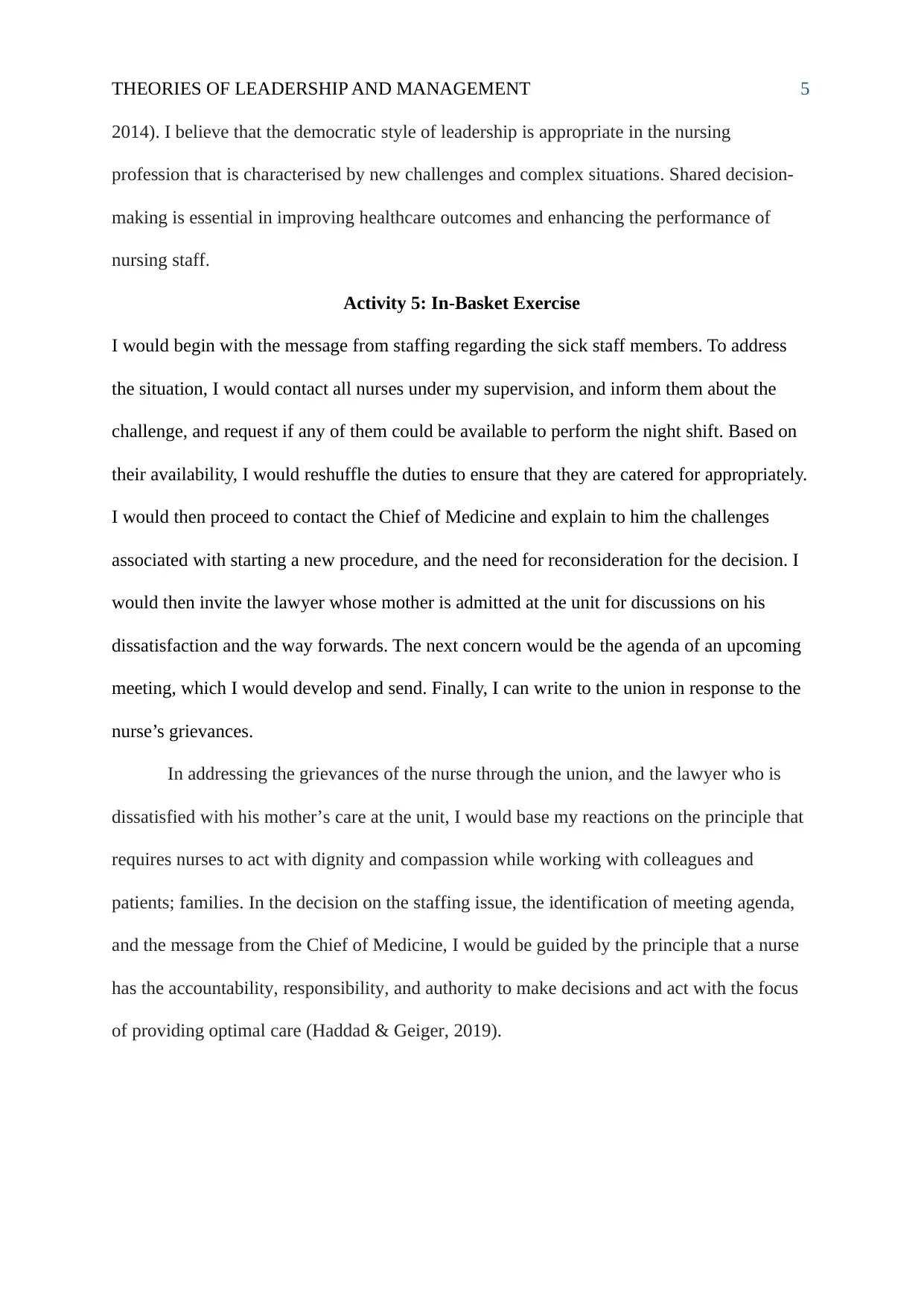
THEORIES OF LEADERSHIP AND MANAGEMENT 5
2014). I believe that the democratic style of leadership is appropriate in the nursing
profession that is characterised by new challenges and complex situations. Shared decision-
making is essential in improving healthcare outcomes and enhancing the performance of
nursing staff.
Activity 5: In-Basket Exercise
I would begin with the message from staffing regarding the sick staff members. To address
the situation, I would contact all nurses under my supervision, and inform them about the
challenge, and request if any of them could be available to perform the night shift. Based on
their availability, I would reshuffle the duties to ensure that they are catered for appropriately.
I would then proceed to contact the Chief of Medicine and explain to him the challenges
associated with starting a new procedure, and the need for reconsideration for the decision. I
would then invite the lawyer whose mother is admitted at the unit for discussions on his
dissatisfaction and the way forwards. The next concern would be the agenda of an upcoming
meeting, which I would develop and send. Finally, I can write to the union in response to the
nurse’s grievances.
In addressing the grievances of the nurse through the union, and the lawyer who is
dissatisfied with his mother’s care at the unit, I would base my reactions on the principle that
requires nurses to act with dignity and compassion while working with colleagues and
patients; families. In the decision on the staffing issue, the identification of meeting agenda,
and the message from the Chief of Medicine, I would be guided by the principle that a nurse
has the accountability, responsibility, and authority to make decisions and act with the focus
of providing optimal care (Haddad & Geiger, 2019).
2014). I believe that the democratic style of leadership is appropriate in the nursing
profession that is characterised by new challenges and complex situations. Shared decision-
making is essential in improving healthcare outcomes and enhancing the performance of
nursing staff.
Activity 5: In-Basket Exercise
I would begin with the message from staffing regarding the sick staff members. To address
the situation, I would contact all nurses under my supervision, and inform them about the
challenge, and request if any of them could be available to perform the night shift. Based on
their availability, I would reshuffle the duties to ensure that they are catered for appropriately.
I would then proceed to contact the Chief of Medicine and explain to him the challenges
associated with starting a new procedure, and the need for reconsideration for the decision. I
would then invite the lawyer whose mother is admitted at the unit for discussions on his
dissatisfaction and the way forwards. The next concern would be the agenda of an upcoming
meeting, which I would develop and send. Finally, I can write to the union in response to the
nurse’s grievances.
In addressing the grievances of the nurse through the union, and the lawyer who is
dissatisfied with his mother’s care at the unit, I would base my reactions on the principle that
requires nurses to act with dignity and compassion while working with colleagues and
patients; families. In the decision on the staffing issue, the identification of meeting agenda,
and the message from the Chief of Medicine, I would be guided by the principle that a nurse
has the accountability, responsibility, and authority to make decisions and act with the focus
of providing optimal care (Haddad & Geiger, 2019).
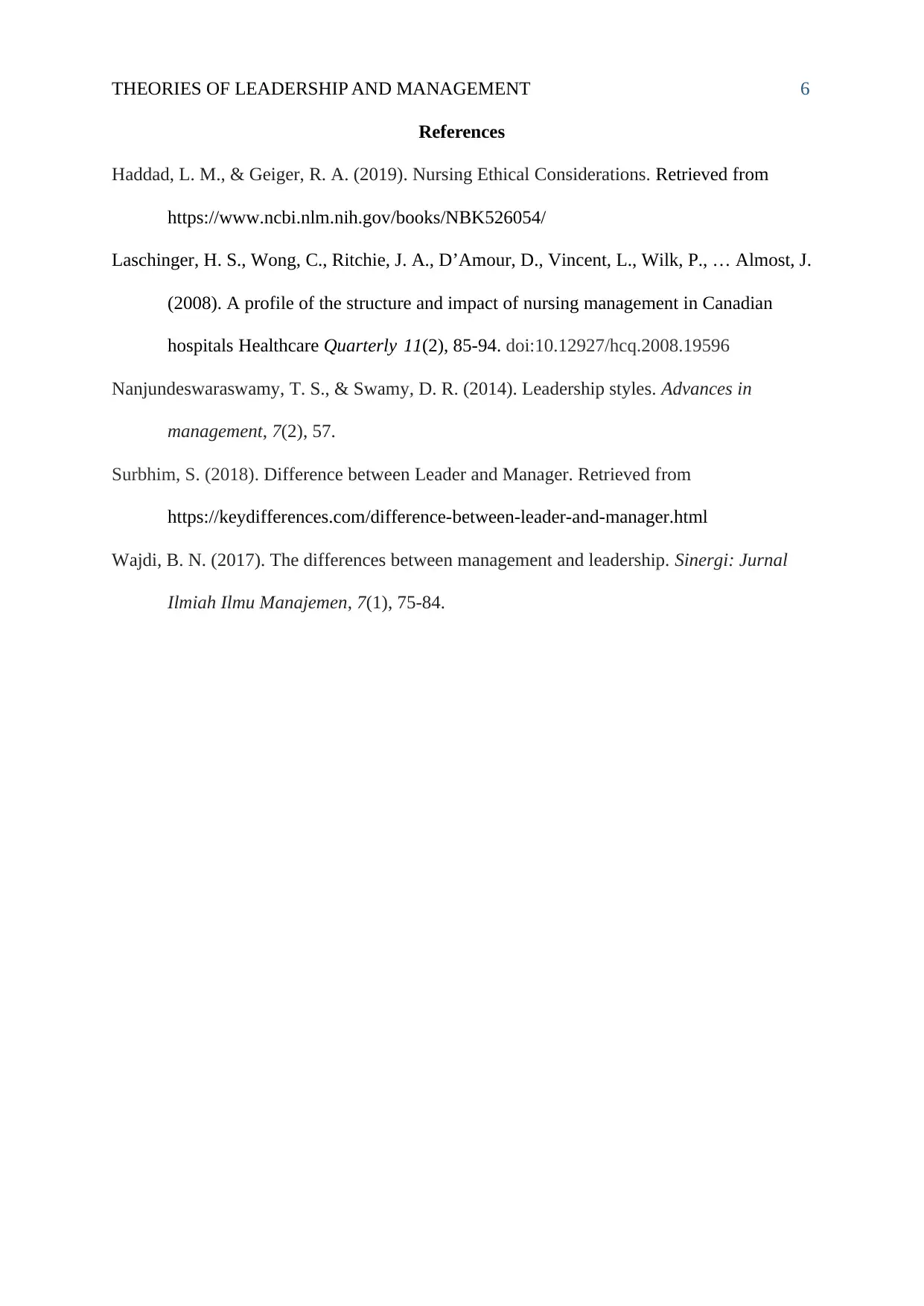
THEORIES OF LEADERSHIP AND MANAGEMENT 6
References
Haddad, L. M., & Geiger, R. A. (2019). Nursing Ethical Considerations. Retrieved from
https://www.ncbi.nlm.nih.gov/books/NBK526054/
Laschinger, H. S., Wong, C., Ritchie, J. A., D’Amour, D., Vincent, L., Wilk, P., … Almost, J.
(2008). A profile of the structure and impact of nursing management in Canadian
hospitals Healthcare Quarterly 11(2), 85-94. doi:10.12927/hcq.2008.19596
Nanjundeswaraswamy, T. S., & Swamy, D. R. (2014). Leadership styles. Advances in
management, 7(2), 57.
Surbhim, S. (2018). Difference between Leader and Manager. Retrieved from
https://keydifferences.com/difference-between-leader-and-manager.html
Wajdi, B. N. (2017). The differences between management and leadership. Sinergi: Jurnal
Ilmiah Ilmu Manajemen, 7(1), 75-84.
References
Haddad, L. M., & Geiger, R. A. (2019). Nursing Ethical Considerations. Retrieved from
https://www.ncbi.nlm.nih.gov/books/NBK526054/
Laschinger, H. S., Wong, C., Ritchie, J. A., D’Amour, D., Vincent, L., Wilk, P., … Almost, J.
(2008). A profile of the structure and impact of nursing management in Canadian
hospitals Healthcare Quarterly 11(2), 85-94. doi:10.12927/hcq.2008.19596
Nanjundeswaraswamy, T. S., & Swamy, D. R. (2014). Leadership styles. Advances in
management, 7(2), 57.
Surbhim, S. (2018). Difference between Leader and Manager. Retrieved from
https://keydifferences.com/difference-between-leader-and-manager.html
Wajdi, B. N. (2017). The differences between management and leadership. Sinergi: Jurnal
Ilmiah Ilmu Manajemen, 7(1), 75-84.
⊘ This is a preview!⊘
Do you want full access?
Subscribe today to unlock all pages.

Trusted by 1+ million students worldwide
1 out of 6
Related Documents
Your All-in-One AI-Powered Toolkit for Academic Success.
+13062052269
info@desklib.com
Available 24*7 on WhatsApp / Email
![[object Object]](/_next/static/media/star-bottom.7253800d.svg)
Unlock your academic potential
Copyright © 2020–2025 A2Z Services. All Rights Reserved. Developed and managed by ZUCOL.




